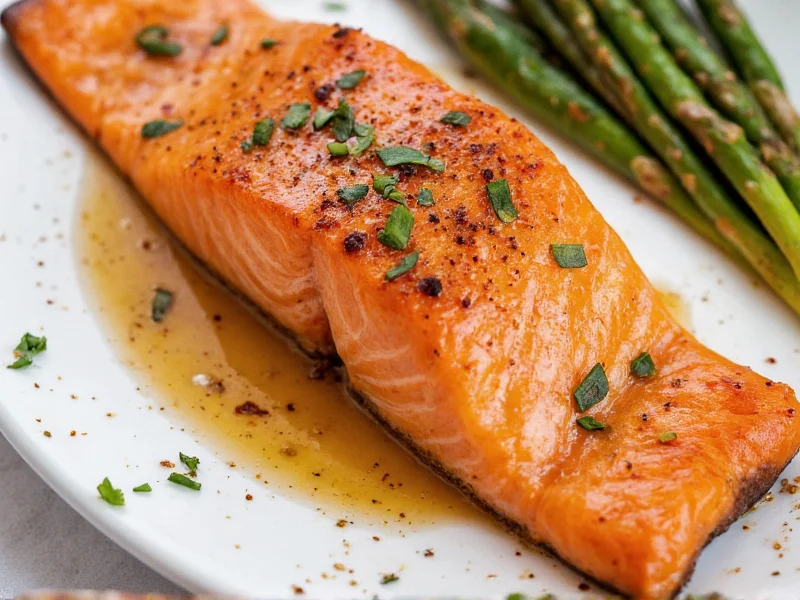Creating the perfect seasoning blend for salmon requires understanding both the science of flavor pairing and the practical realities of home cooking. While commercial "magic salmon seasoning" products exist, the most versatile and satisfying results come from understanding the principles behind effective salmon seasoning rather than relying on proprietary blends.
The Science Behind Effective Salmon Seasoning
Salmon's unique fatty acid profile creates both opportunities and challenges for seasoning. The omega-3 rich oils in salmon readily absorb fat-soluble flavor compounds, making certain spices particularly effective. Understanding this interaction is key to creating seasoning that penetrates rather than merely coats the fish.
Research in food chemistry shows that compounds like limonene (found in citrus zest) and rosmarinic acid (in rosemary) bind particularly well with salmon's fat molecules, creating flavor integration that withstands cooking temperatures. This explains why simply sprinkling dried herbs on cooked salmon often produces disappointing results compared to incorporating them into a rub applied before cooking.
Essential Components of a Magic Salmon Seasoning Blend
A truly effective salmon seasoning contains four critical elements working in harmony:
| Component Type | Function | Common Ingredients |
|---|---|---|
| Acidic Elements | Breaks down surface proteins, allows deeper flavor penetration | Lemon zest, orange zest, citric acid |
| Aromatic Herbs | Provides complex herbal notes that complement salmon's richness | Dill, tarragon, fennel pollen, rosemary |
| Umami Enhancers | Boosts savory perception without overpowering | Onion powder, garlic powder, smoked paprika |
| Subtle Sweetness | Counteracts potential bitterness, promotes caramelization | Light brown sugar, maple sugar, honey powder |
Creating Your Own Magic Salmon Seasoning: A Flexible Recipe
While commercial blends vary, the following ratio-based recipe allows customization based on your cooking method and personal preferences. This homemade magic salmon seasoning recipe yields approximately ¼ cup:
- 2 tablespoons paprika (smoked for grilled salmon, sweet for baked)
- 1½ tablespoons dried dill (or 1 tablespoon fresh, finely minced)
- 1 tablespoon lemon zest (dried or fresh)
- 2 teaspoons garlic powder
- 2 teaspoons onion powder
- 1½ teaspoons light brown sugar
- 1 teaspoon black pepper (coarsely ground)
- 1 teaspoon sea salt
- ½ teaspoon cayenne pepper (optional for heat)
Mix thoroughly and store in an airtight container. For best results, combine ingredients at least 24 hours before use to allow flavor integration—a crucial step many salmon seasoning without MSG recipes overlook.
Application Techniques for Maximum Flavor Impact
The timing and method of applying your magic salmon seasoning ingredients significantly affects results:
- Dry brine method (best for thick cuts): Mix 1 part seasoning with 3 parts salt, apply to salmon 30-60 minutes before cooking. Rinse lightly before cooking.
- Rub method (versatile): Pat salmon dry, apply seasoning 15-20 minutes before cooking to allow surface absorption.
- Oil incorporation (for grilling): Mix seasoning with 1 tablespoon oil per pound of salmon to create a paste that adheres during high-heat cooking.
Avoid applying seasoning containing sugar too early when using high-heat methods, as this can cause premature caramelization and burning. This is a common mistake in salmon seasoning for grilling applications.
Matching Seasoning to Cooking Methods
The ideal perfect salmon seasoning blend varies based on your cooking technique:
- For baked salmon: Increase aromatic herbs (dill, tarragon) by 25% and reduce sugar slightly. Baking allows more delicate flavors to shine.
- For grilled salmon: Boost smoked paprika and add ½ teaspoon of chipotle powder for complementary smokiness that withstands high heat.
- For pan-seared salmon: Reduce overall quantity by 20%—the direct contact with hot surface intensifies flavor perception.
- For cedar-plank cooking: Emphasize citrus elements (increase lemon zest by 50%) to complement the wood's natural compounds.
Common Magic Salmon Seasoning Mistakes to Avoid
Even with the best healthy salmon seasoning recipe, these errors can ruin your results:
- Applying too late: Seasoning needs time to interact with the fish's surface proteins—apply at least 15 minutes before cooking.
- Over-salting: Many commercial blends contain excessive salt; when making your own magic salmon seasoning, control salt separately.
- Ignoring moisture content: Pat salmon dry before seasoning application—water prevents proper adhesion and flavor penetration.
- Using old spices: Ground spices lose potency within 6 months; freshness dramatically impacts the how to make salmon seasoning from scratch results.
Storage and Shelf Life Considerations
Proper storage maintains your seasoning's effectiveness. Store in an airtight container away from light and heat. A well-made magic salmon seasoning blend retains peak potency for:
- 3-4 months in a cool, dark pantry
- 6-8 months when refrigerated
- 10-12 months when frozen (best for large batches)
Test potency by rubbing a small amount between damp fingers—if the aroma is weak, it's time to refresh your blend. This is particularly important for the citrus components, which degrade faster than dried herbs.
Customizing for Dietary Preferences
The beauty of creating your own homemade magic salmon seasoning recipe is adaptability:
- Keto-friendly version: Replace sugar with ½ teaspoon erythritol or omit entirely
- Sodium-restricted version: Reduce or eliminate added salt, relying on umami elements for flavor depth
- Allium-free version: Substitute onion and garlic powders with 1 teaspoon celery seed and ½ teaspoon asafoetida
- Smoky alternative: For those avoiding smoked paprika, add ⅛ teaspoon liquid smoke to the oil when creating a paste











 浙公网安备
33010002000092号
浙公网安备
33010002000092号 浙B2-20120091-4
浙B2-20120091-4